Brewing a Norwegian farmhouse ale

Amble gård |
When cousin Svein asked if I wanted to come to Sogndal to learn how to brew a traditional Norwegian farmhouse ale there was only one possible answer. One of the researchers at Western Norway Research Institute, Carlo Aall, is a traditional brewer, and offered to teach the other employees the art of traditional brewing. To give us an experience closer to the original, he'd been allowed to use the brewhouse at Amble Gård, a farm in nearby Kaupanger. I'll describe the procedure first, then give the recipe at the end.
We started brewing at around 1100 on the Tuesday morning, and finished up the last tasks around 2230 the same evening. Everything had been prepared the evening before, and some things had to be done later that night and the next morning, but the bulk of the work was done in those eleven hours. The reason it took so long was that we really were doing it the traditional way, using only tools that would have been the same a century ago (except for the thermometer and the garden hose). And because we were brewing 150 liters. Scaling traditional brewing methods, even to batches as small as 150 liters, is a considerable challenge, as you'll see.
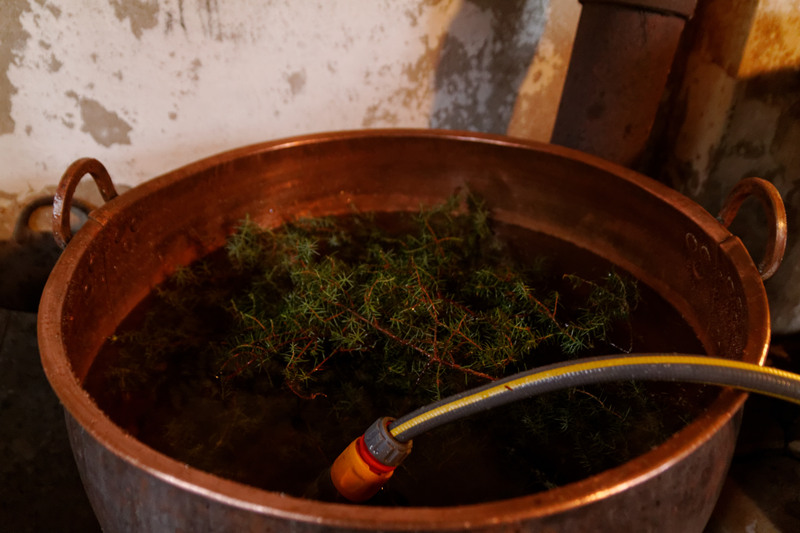
Heating juniper infusion |
In traditional brewing, juniper infusion replaces water for all purposes, like cleaning, mashing, etc etc. In Norwegian it's usually called "einerlåg" or "sprakalåg". So the first thing we had to do was to start the fire under the kettle, fill it with water, then take some juniper branches and put them in. Carlo says it's important to also take a branch and split it lengthwise, so that we extract juices from the core of the wood. When asked why he shrugged in a vaguely embarrassed way, and said "I was told this is important, but not why."
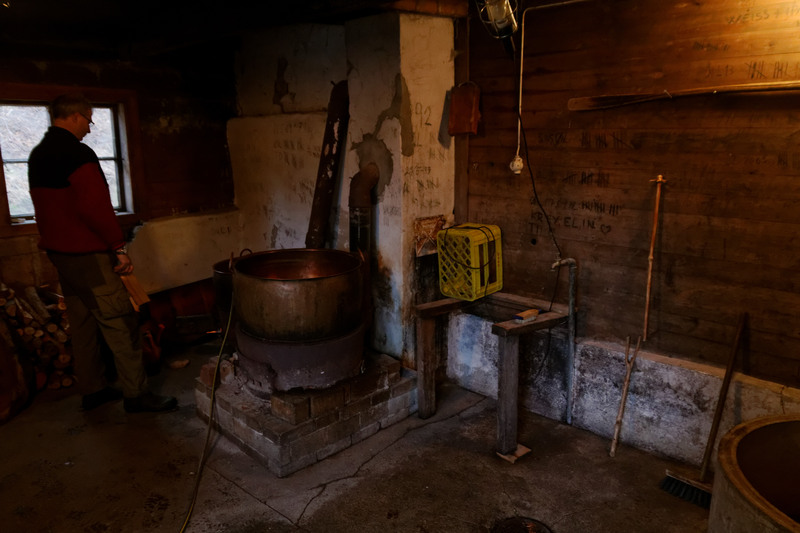
Inside the brewhouse |
This prompted him to tell the story of his mother teaching him to make steak. She taught him that it was really important to cut off each end of the steak. Asked why she said that's how she'd learned to do it. So he made it that way, but later he asked his grandmother why. "Oh," she said, "that's because our old oven was too narrow." Some of the parts of the recipe are like this: tradition dictates it be done this way, and most of the rules are important, but some probably are not, but there's no obvious way to tell which is which. So I'll reproduce everything exactly and leave you to judge.
Another thing you should be aware of is that in traditional brewing, everyone does it differently. It's like grandmas making meat balls. The result is always recognizably meat balls, but there are as many recipes as there are grandmothers. Carlo's wife did a book of traditional food recipes from Sogn and quickly discovered that she had to include ten different versions of each recipe to avoid complaints like "this isn't the right recipe!" So be aware that this is a recipe for Norwegian farmhouse ale, not the recipe.
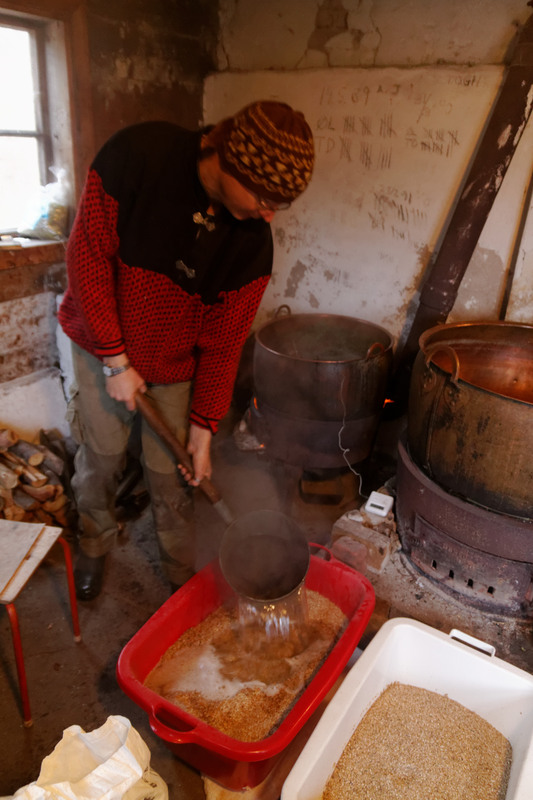
Carlo mashing |
Anyway, while the juniper infusion heated we put out four plastic tubs and poured a suitable amount of ground malts into each. The juniper infusion should not go above 80C, as that will extract unhealty substances from the wood. Once the infusion reached 80 we poured some of it into the tubs using a ladle, while stirring the mash with a mashing fork. The temperature in the mash should ideally be 72C. When the mash is so wet that the fork is only just able to stand, the water/malt ratio is right.
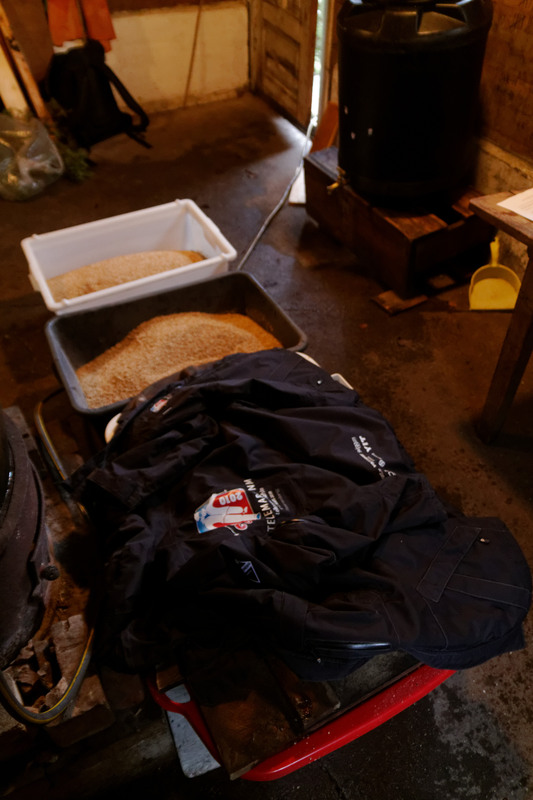
Mashing under a lid |
We placed some wooden lids and clothes over the mash tubs, in order to keep the temperature as high as possible, then left the tubs for at least an hour. The smaller kettle only produced enough juniper infusion for the first two tubs, so we had to wait for the kettle to be heated again to mash the second two tubs. Here we faced the scaling issues for the first time: using a wood-fired kettle producing enough water at the right temperature at the right time is a challenge.
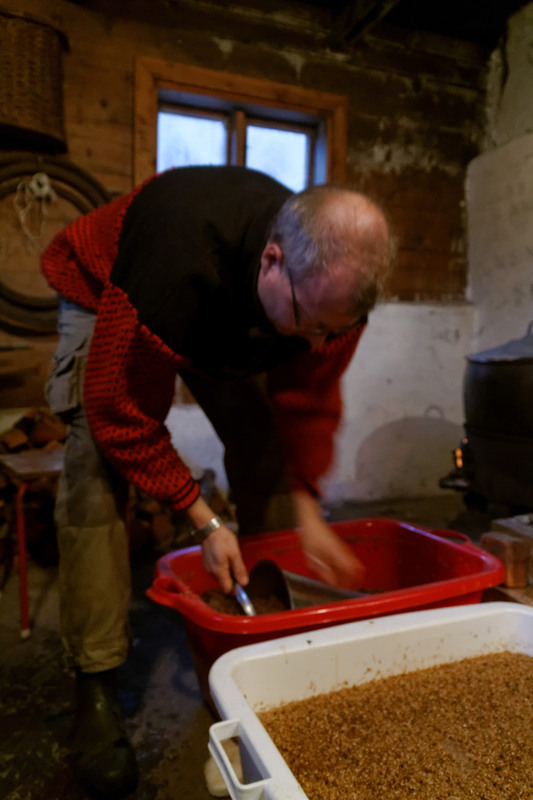
Transferring the mash |
Anyway, after about an hour we used a bucket to move the mash from the tubs into a tun. (Mashing should be at least an hour, ideally two.) The bottom of this tun was filled with about 20cm of juniper branches, with a wire mesh on top, to serve as a filter. Traditionally, this tun is referred to as "rostabidnet," which literally means something like "the filter tun". This is where we run water through the mash to produce the wort. Once all the malt was mashed and filled in the tun, we opened a tap at the bottom of the barrel, and ran off a bucket of wort. This first wort was deliciously sweet and full-bodied, tasting of grain, caramel, and syrup. The first bucket must always be poured back on top of the barrel. Why? Nobody knows. (Edit: From a Reddit comment I learn that this is vorlauf.)

Rostabidnet |
Anyway, we ran off bucket after bucket of wort from the tun, each time pouring a bucket of juniper infusion on top, to replace what we had drained off. The faucet must be carefully tuned, so that out of the tap comes an even flow, no thicker than a woolen thread. The buckets of wort were poured into the empty kettle, which was then fired to make the wort boil. The running took a long time, as bucket after bucket was poured into the tun, but it was an easy, relaxing time.

Tuning the tap |
One tricky aspect of the running is deciding when to stop. The first wort is thick and viscous, almost like syrup, but it gradually gets thinner, and starts tasting more of grain and less of syrup. There's no obvious rule for when to stop, but by counting the buckets you can get an idea of how much liquid you're extracting. Carlo stopped when the wort no longer felt sweet. It still had some body, but the sweetness had gone out of it.
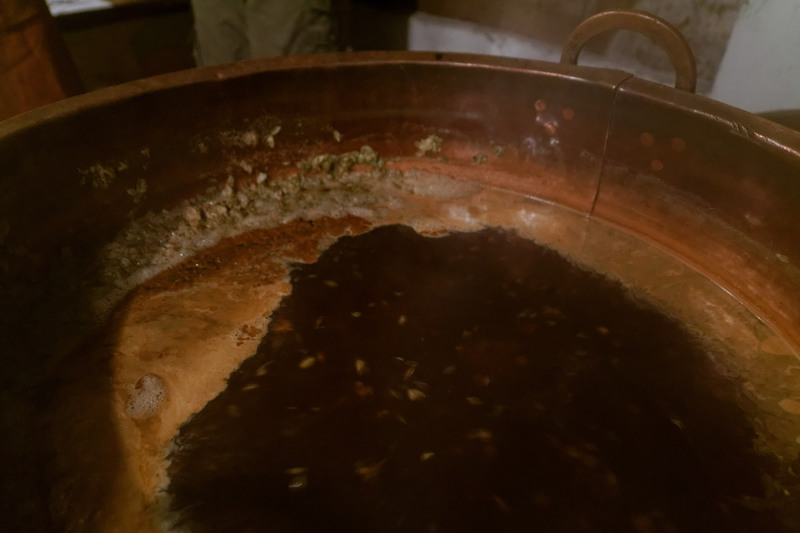
Boiling |
The wort was then boiled for an hour, which again proved to be a challenge, as we had more wort than there was room for in the big kettle. Since the other kettle was used for juniper infusion for the running, wort had to be temporarily stored (before boiling) in the mash tubs on the floor. This involved lots of ladling, tuning of the wood fire, etc etc etc. On top of that we had to measure out the hops and add them to the kettle at the right times (details in recipe).
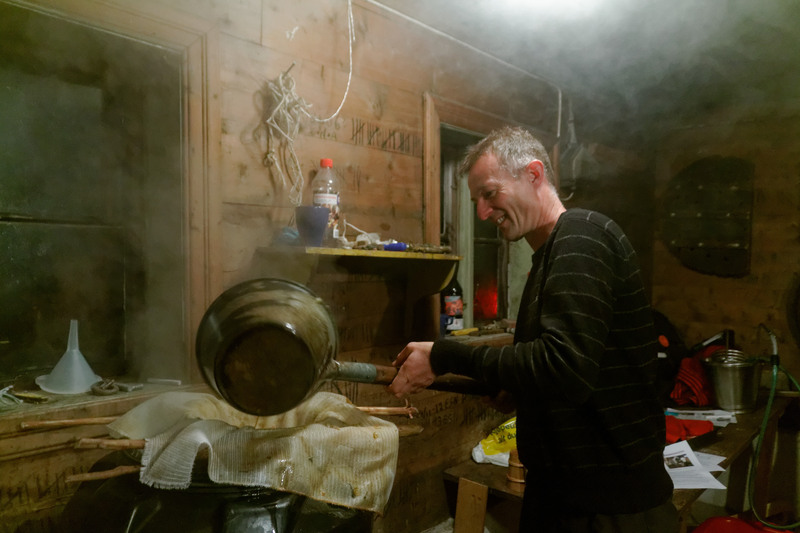
Ladling into fermenter |
Once it had finished boiling, the wort was transferred by ladle to another tun, which we placed in a shallow concrete basin inside the brewery. This basin had a small hole at the bottom, so that water could easily be emptied into the drain. We plugged the hole with a rubber plug, then poured cold water into the well, to cool off the wort. We used a cloth to filter out bits of juniper and hops, but in summer you'd normally leave the hops in until the end of the primary fermentation.

Scooping out malts |
Once the running was finished we had to remove the malts, which was non-trivial. We had to dig at least 80 kilos of water-logged malts out through a narrow opening at the top of the tun, using the ladle, then take it away with a wheelbarrow to give to the horses. Then came lots of cleaning and scrubbing to make the equipment free of sugary wort. When all this was done, the wort was still not cool enough (20C) for the yeast to be added, so most of us went home, while two people stayed around to wait for it to cool.
After more than 11 hours of intermittent physical labour, with nothing to sit on, I was about to keel over, and promptly did so on returning to my aunt's house.
Note that a few days later, after primary fermentation, there would be the traditional "oppskåk". That's the party the brewer would have for his neighbours as the beer was transferred to secondary fermentation. Since I'd flown back to eastern Norway I couldn't be present for that, so I have no idea what it tasted like. After two to four weeks in secondary fermentation the beer will be ready to drink. With luck we'll find someone to transport a few bottles from Sogndal to me here in the Oslo area...
The recipe
The above gives the process, but doesn't say much about the ingredients, so we'll do that here. Note that, as I've said before, when traditional brewing comes under pressure, the traditions die out gradually. In the Sogndal area, many aspects of true Norwegian farmhouse brewing have disappeared, so this is not the most traditional ale we could have made. One reason I'm writing about it in so much detail is that I think that makes it ideal for any home brewers who want to try their hands at brewing this themselves. I'll produce some more traditional recipes later, if I can get hold of the information.

Measuring out hops |
Anyway, let's do the ingredients one by one. Note that you really do need the juniper.
- Juniper branches
- You need enough to fill up the water fairly well. Make sure to take branches that don't have many berries, as you don't want too much of what's in the berries. The variety in question is Juniperus communis, which can be hard to get hold of in the US.
- Malts
- You need roughly 0.4kg of malts per liter of wort you intend to produce. I'll give a detailed grist below. The malts were normal international malts, but ideally we should have malted Norwegian barley ourselves.
- Hops
- Carlo didn't know what hops we were using, but they weren't terribly aromatic, so I think a central European noble hop would work well. We used 270 grams for roughly 150 liters. 80% is added at the start of the boil, 15% added 15 minutes before the end, and 5% at 5 minutes before.
- Yeast
- We used Safale ale yeast. I think any relatively neutral ale yeast will do, although obviously the ideal is kveik.
The detailed grist was as follows. Note that this is for a dark, Christmas-style beer. For a summer beer you'd use a paler grist.
- 50kg Munich malts
- 20kg pale ale malts
- 4kg crystal malts
- 0.3kg chocolate malts
Original gravity? Final gravity? Alcohol percentage? IBUs? You can forget about all that. This is traditional brewing. Carlo reports that after primary fermentation the beer tasted of "porter essence" and had the consistency of sauce, so he added 10% juniper infusion to thin it out.
I think that's everything. If I've forgotten something, please don't hesitate to ask questions in the comments.
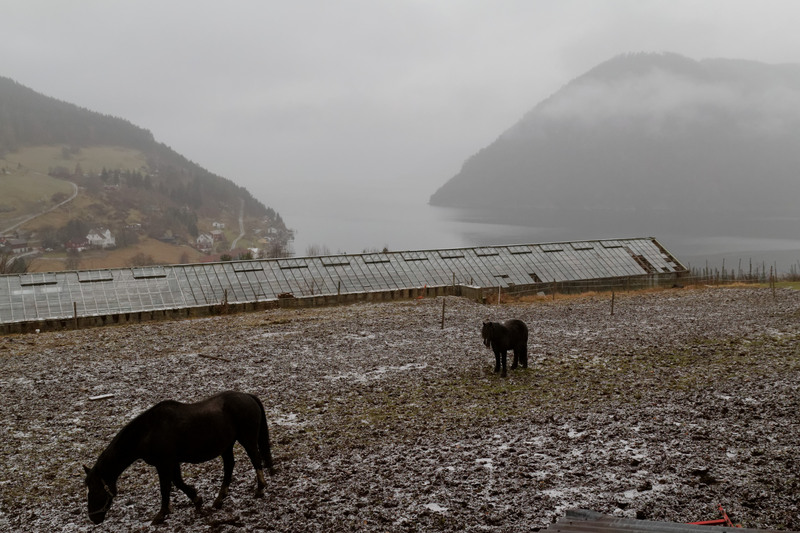
Horses |
Similar posts
Brewing raw ale in Hornindal
I tried a Hornindal raw ale at a tasting with friends, and was blown away, for two reasons
Read | 2015-12-26 11:35
Brewing in Morgedal
The farmhouse survey showed that brewing in Telemark was still alive in the 1950s, but for a long time I thought it had died out
Read | 2015-10-29 14:00
Comments
Svein Ølnes - 2013-12-01 17:02:06
Very nice. To my relief you didn't mention the barrel that overturned and the spilled wort.. ;)
It was indeed very interesting to follow the process (almost) from start until the end (adding yeast to the wort). I look forward to tasting the beer.
Anyone being in Sogndal on the 13th of Dec. will have a taste. Just go to Fosshaugane Campus, Storhallen, where the beer will be served.
Cory - 2013-12-01 17:51:19
Great article. I have heard of the branches being used like a false bottom, but I had never heard of heating all the water used in the branches. Perhaps as some sort of water treatment, or do you think it is more for flavoring?
Lars Marius - 2013-12-02 03:18:30
@Svein: Thank you. Yeah, good thing nobody's heard of that. :)
@Cory: Juniper infusion has traditionally been used for all kinds of cleaning purposes, so I think that's probably where it started. It's part of the flavour now, and I guess it might have other uses, too, but I don't know what they are. I do know it adds considerably to the IBU of the beer, but you can't necessarily taste the bitterness.
Ramtyns - 2013-12-16 17:20:51
What a great report! I was also surprised to hear of using juniper infusion as opposed to branch filter. Cory may have a point here, water treated this way could at least theoretically have some different mineral profile and influence the mashing process (in modern practices, different salts are used to adjust water profile, for example to "burtonize" it). For example, a Lithuanian countryside brewer Perevičius uses branch bed technique and says that it influences the mouthfeel of the resulting beer significantly. Extracting tannings from the branches is one thing that could affect the flavor, too. Practical reasons aside, it might be ritual reasons - juniper is thought to have some clensing/disinfecting properties in some cultures.
Hm, it asks for an experiment and I can feel my hands itching! There's a large juniper cluster near to my hometown, maybe it's just the time to pay it a visit.
Speaking about hops, what is the history of hops in Norway?
Lars Marius - 2013-12-17 15:14:18
@Ramtyns: Note that there is a branch filter, too: http://www.garshol.priv.no/tmphoto/photo.jsp?id=t311659
Yes, the juniper could potentially have all sorts of effects, but beyond the IBU I don't know what they are. It's quite possible that you can taste it. At least I've tasted juniper in several beers, like Haandbryggeriet Norwegian Wood, and Huvila Arctic Circle.
As far as I can make out, hops in beer came to Norway a bit later than other places, maybe 14th century. It was imported to begin with, but eventually there was a concerted effort to start growing it in Norway (17th century, I think), and several places in south-western Norway had considerable hop growing. Apparently itinerant hop sellers would move around selling the hops, even going into Sweden.
Eventually it died out, but there are still Norwegian varieties of hops, both growing wild and in gene banks. There was an attempt to grow some of these varieties in 2011 or 2012, but they had difficulty getting them to grow.
Darren J Engh - 2015-10-16 00:29:11
Thank you for your work. I'm a 5th generation Norwegian from Westby, Vernon county, Wisconsin, United states of America. I am PROUD to say that I am 100% Norwegian Heritage 5th Generation american and still 100% Norsk. All 16 Of my Great, Great grandparents come from The Oppland Norway area. That being said, I am excited to try to make an ale from my old country for Christmas. I have a 10 gal brew system and have been brewing for the past 7 years. If you have a basic recipe that you'd like to share, I'd be so Appreciative. Most of my family is from the Faaberg and Trenten areas. Even without a response, I plan on attempting the Norwegian farmhouse ale recipe you Posted.
Lars Marius - 2015-10-16 03:41:54
@Darren: The ethnological survey has responses from both Fåberg and Tretten, but unfortunately those are very basic, and give only a vague outline of how people brewed. It's clear that the process was different from the one in this blog post, though, because they boiled the mash. I really ought to publish a boiled-mash recipe, so I'll try to take you up on this and put together a recipe based on the response from Vestre Gausdal, which is just west of Fåberg/Tretten.
Unfortunately, that's a bit of work, and going to take some time, because the blog has a huge backlog of posts that should have been written, going all the way back to May.
Kyle Warren - 2020-01-16 15:06:57
Wonderful article! I adapted the recipe to the best of my abilities and was extremely pleased with the results! I used hornindal to ferment with. I didn't receive my juniper in time and ended up dry hopping with it instead of putting it into the mash water. The flavor profile was almost schizophrenic. It was fruity and toasty and chocolaty and herbaly all at the same time. However, they all melded perfectly well together. Thank you for the article and providing as much info as you could!
Damian - 2020-04-02 10:00:18
Hi, great blog, great article like always! I'm going to homebrew some Norwegian farmhouse ale. At this point have ewery ingredients but I lack in information about juniper infusion. Can you help me with amount of branches/green part of juniper per liter? I read somwhere to use from 10grams/l to 25grams/l. I don't where to start. Please advice me! Thanks a lot!
Lars Marius Garshol - 2020-04-02 10:14:58
@Damian: Juniper is a little like hops: it's not simply a question of grams per liter. It matters what kind and how you treat it. So building experience with the ingredient is probably a good idea.
As a start I would recommend using only thin twigs, where the stems are no thicker than a finger. Black berries are good. If you don't boil the infusion, 100g per liter of infusion is good. If you do boil, 50g. If you boil, take extra care to avoid thick stems.
A hot steep at 2-3 hours gives extra aroma.